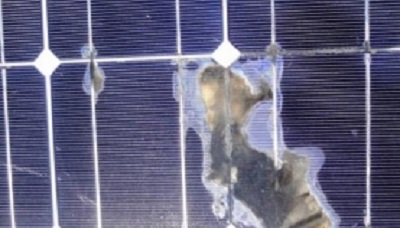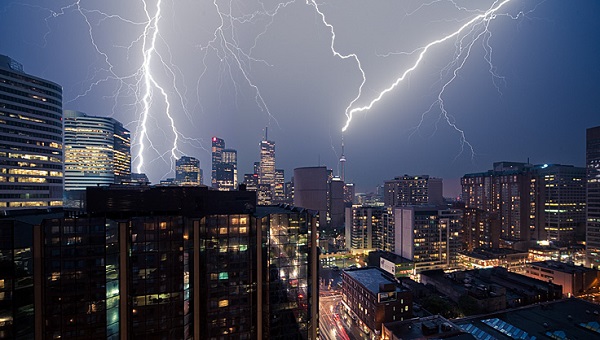Lightning can cause devastating damage to solar panels and protection needs to be considered during the design stages.
Lightning strikes, whether direct or indirect, can result in both down time and expenses in identifying and replacing damaged parts. Direct strikes, while rare, would destroy (melt) panels, inverters, etc.
Indirect strikes, which are more likely, would induce high voltages into the system breaking down conductors, PV panels and components as well as producing dangerous sparking that could ignite combustible material.
 Damage caused by a lightning strike on a solar panel. Image Credit: 30 North Solar
Damage caused by a lightning strike on a solar panel. Image Credit: 30 North Solar
Companies that insure solar projects have become increasingly interested in lightning protection, especially in areas where there is a high occurrence of lightning expressed as lightning flash density (yearly number of flashes per square kilometer).
PV farms installed in open areas where there are no high buildings or trees have a high probability of being hit by lightning and should seriously consider lightning protection in their solar designs. Likewise, roof-mounted solar panels on high buildings are also a target and should be protected. Requirements for lightning protection of solar panels can be found in NFPA780, the standard for the installation of lightning protection systems.
The requirements in chapter 12 of NFPA780 refer back to the basic requirements for ordinary structures in chapter 4 and add specific requirements for solar panels. The fundamental principle of lightning protection is based on placing the solar panels within a zone of protection so that downward lightning leaders attach to streamers emanating from air terminals or other strike termination devices and is directed to ground rather than hitting the panel and/or other components of the solar system and causing damage.
Installing air terminals to protect PV panels can be tricky since you don’t want to shade the panels and, if avoidable, you don’t want to place the air terminals on the PV rack, since a lightning strike to the air terminal would place some of the lightning current on the panel that may result in damage.
All air terminals need to be interconnected and tied into a grounding ring electrode system for ground-mounted panels where the lightning current will safely dissipate into the earth.
The metal rack on ground-mounted systems that are not part of the lightning protection system need to be bonded to the system to reduce side flashes or sparking to the solar panels.
Critical to an effective lightning protection system are surge protection devices (SPDs) to suppress lightning induced high voltages to ground and avoid damage to the PV system. Most damage occurs from nearby lightning strikes to ground, usually within a few hundred feet. A near-strike can induce thousands of volts onto the PV system if not protected.
Listed DC, or PV SPDs, as well as AC SPDs, need to be installed at various locations within the system, such as on the input and output of the inverter. PV SPDs are evaluated to Supplement SA of UL 1449, The Standard for Surge Protective Devices.
Underwriters Laboratories (UL) certified lightning protection systems for solar panels verifies that the system complies with NFPA780 and will give owners, investors, inspectors and insurance companies the assurance that the solar panels will be protected. As an independent third party, UL will inspect the system and determine compliance. Compliance will result in the issuance of a certificate.
If non-conformances are noted during the inspection, the findings will be detailed in a letter report and we will work together to resolve the issues.
UL would be interested in any information pertaining to lightning events that resulted in damage to the PV system so that we can better understand how PV systems can be protected through the development of better requirements.
This article was authored for Solar Power World Online by Joseph DeGregoria, P.E. He is a Principal Engineer at UL and responsible for several product categories, including Surge Protective Devices and Lightning Protection Systems. He can be contacted at [email protected].
Published here with permission from the original publication By Kelly Pickerel.












Comments